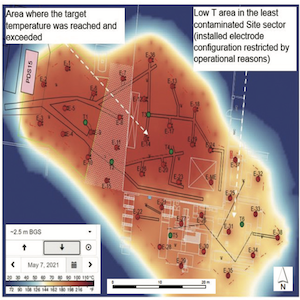Remediation of chlorinated solvents with Electrical Resistance Heating (ERH) at an active industrial site in Italy

All claims expressed in this article are solely those of the authors and do not necessarily represent those of their affiliated organizations, or those of the publisher, the editors and the reviewers. Any product that may be evaluated in this article or claim that may be made by its manufacturer is not guaranteed or endorsed by the publisher.
Authors
Italian legislation defines stringent groundwater chemical quality criteria, to be applied at a site’s downgradient property boundary, irrespective of whether the underlying aquifer is, or could be, used for water resource purposes. In some scenarios, the regulatory authorities may identify less stringent standards, but this rarely occurs. This means that many sites with groundwater contamination are managed using hydraulic barriers, as source zone remediation may not achieve the stringent groundwater standards required due to technology limits or time constraints; therefore, the parties responsible for contamination often decide to continue to operate these hydraulic barriers indefinitely. This article describes the first application in Italy of source treatment using Electrical Resistance Heating (ERH), a remediation technology capable of removing a large percentage of contaminant mass, at a site where a hydraulic barrier is operating within a low yielding aquifer that is not used for water supply. The implementation of this technology was possible since the source zone was far from the downgradient site boundary, thus making achievement of the stringent quality standards at the boundary possible within a reasonable timeframe. The ERH system recovered of about 600 kg of contaminants within a timeframe of 8 months and achieved a reduction of contaminant concentrations in the most impacted areas greater than 90%. This article also emphasizes that, in similar low yielding aquifers, setting less stringent groundwater standards at the site boundary whilst still protecting downgradient receptors may promote more widespread implementation of source remediation activities in Italy.
How to Cite

This work is licensed under a Creative Commons Attribution-NonCommercial 4.0 International License.
PAGEPress has chosen to apply the Creative Commons Attribution NonCommercial 4.0 International License (CC BY-NC 4.0) to all manuscripts to be published.














